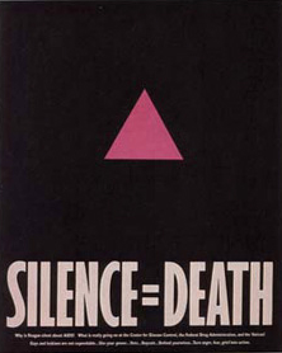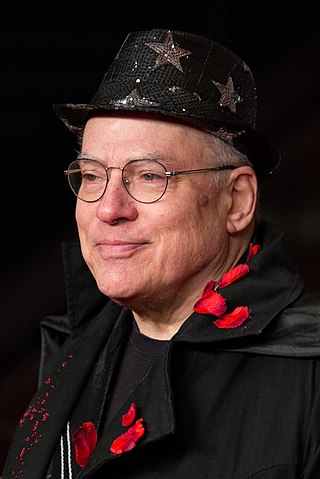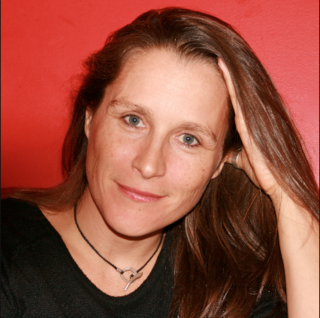
AIDS Coalition to Unleash Power is an international, grassroots political group working to end the AIDS pandemic. The group works to improve the lives of people with AIDS through direct action, medical research, treatment and advocacy, and working to change legislation and public policies.

Emerging from ACT UP in 1988, Gran Fury was an AIDS activist artist collective from New York City consisting of 11 members including: Richard Elovich, Avram Finkelstein, Amy Heard, Tom Kalin, John Lindell, Loring McAlpin, Marlene McCarty, Donald Moffett, Michael Nesline, Mark Simpson and Robert Vazquez-Pacheco.

Holger Bernhard Bruno Mischwitzky, known professionally as Rosa von Praunheim, is a German film director, author, producer, professor of directing and one of the most influential and famous queer activists in the German-speaking world. A pioneer of Queer Cinema and gay activist from the very beginning, von Praunheim was a key co-founder of the modern lesbian and gay movement in Germany and Switzerland. He was an early advocate of AIDS awareness and safer sex. His films center on queer-related themes and strong female characters, are characterized by excess and employ a campy style. They have featured such personalities as Keith Haring, Larry Kramer, Diamanda Galás, William S. Burroughs, Allen Ginsberg, Judith Malina, Jeff Stryker, Jayne County, Divine, Charlotte von Mahlsdorf and a row of Warhol superstars. In over 50 years, von Praunheim has made more than 150 films. His works influenced the development of LGBTQ+ movements worldwide.

The New York Native was a biweekly gay newspaper published by Charles Ortleb in New York City from December 1980 until January 13, 1997. It was the only gay paper in New York City during the early part of the AIDS epidemic, and pioneered reporting on AIDS when most others ignored it. The paper subsequently became known for attacking the scientific understanding of HIV as the cause of AIDS and endorsing HIV/AIDS denialism.
Carrie Moyer is an American painter and writer living in Brooklyn, New York. Moyer's paintings and public art projects have been exhibited both in the US and Europe since the early 1990s, and she is best known for her 17-year agitprop project, Dyke Action Machine! with photographer Sue Schaffner. Moyer's work has been shown at the Whitney Biennial, the Museum of Arts and Design, and the Tang Museum, and is held in the permanent collections of the Metropolitan Museum of Art. She serves as the director of the graduate MFA program at Hunter College, and has contributed writing to anthologies and publications like The Brooklyn Rail and Artforum.
Lesbian feminist art activist collective fierce pussy was founded in 1991 in New York City. It is committed to art action in association with the AIDS Coalition to Unleash Power. The group uses lower case letters for their name in part because it is non-hierarchical. fierce pussy, as a collective, speaks of themselves as a singular person. This is consistent in an interview on their 2018-19 window installation at the Leslie-Lohman Museum of Art. In the interview, fierce pussy states that "you don't need to refer to us as individual artists, all responses from our side are by fierce pussy. We are fierce pussy."

Catherine Gund is an American producer, director, and writer who founded Aubin Pictures in 1996.

United in Anger: A History of ACT UP is a 2012 documentary film directed by Jim Hubbard and produced by Hubbard and Sarah Schulman about the beginning and progress of the AIDS activist movement from the perspective of the people fighting the epidemic. Archival footage with oral histories of members of ACT UP depicts the history of civil disobedience against corporate greed, social indifference, and government negligence in the face of AIDS. The film captures the efforts of ACT UP to remove the stigma associated with AIDS, push the prioritization of experimental drug research and testing, and provide a context for the devastating effects of the epidemic. The film includes several actions by ACT UP: Seize Control of the FDA, Stop the Church, and Day of Desperation.

The AIDS pandemic began in the early 1980s and brought with it a surge of emotions from the public: they were afraid, angry, fearful and defiant. The arrival of AIDS also brought with it a condemnation of the LGBT community. These emotions, along with the view on the LGBT community, paved the way for a new generation of artists. Artists involved in AIDS activist organizations had the ideology that while art could never save lives as science could, it may be able to deliver a message. Art of the AIDS crisis typically sought to make a sociopolitical statement, stress the medical impact of the disease, or express feelings of longing and loss. The ideologies were present in conceptions of art in the 1980s and are still pertinent to reception of art today as well. Elizabeth Taylor, for example, spoke at a benefit for AIDS involving artwork, emphasizing its importance to activism in that "art lives on forever". This comment articulates the ability of artwork from this time to teach and impact contemporary audiences, post-crisis. This page examines the efforts of artists, art collectives, and art movements to make sense of such an urgent pandemic in American society.
Dyke Action Machine! or DAM! is a public art and activist duo made up of painter and graphic designer Carrie Moyer and photographer Sue Schaffner. DAM! gained notoriety in the 1990s for using commercial photography styling with lesbian imagery in public art.
Jean Carlomusto is a New York filmmaker, AIDS activist, and interactive media artist. She produced and directed HBO's Emmy nominated documentary, Larry Kramer in Love & Anger, which was featured at the Sundance Film Festival. Her works have been exhibited internationally in festivals, museums and on television. She was an early pioneer in documenting the AIDS crisis. As the founder of the Multimedia Unit at Gay Men's Health Crisis, she created the television series Living with AIDS. She was a founding member of DIVA TV and a member of the Testing The Limits Video Collective.

The Silence=Death Project, best known for its iconic political poster, was the work of a six-person collective in New York City: Avram Finkelstein, Brian Howard, Oliver Johnston, Charles Kreloff, Chris Lione, and Jorge Soccarás.
Lola Flash is an American photographer whose work has often focused on social, LGBT and feminist issues. An active participant in ACT UP during the time of the AIDS epidemic in New York City, Flash was notably featured in the 1989 "Kissing Doesn't Kill" poster.
William "Bill" R. Olander was an American senior curator at the New Museum of Contemporary Art in New York City. He previously worked as curator and director of the Allen Memorial Art Museum. He was a co-founder of the arts organization Visual AIDS.

Raymond Robert Navarro was an American video artist, filmmaker, and HIV/AIDS activist. Navarro was an active member of ACT UP and a founder of Diva TV. His activism was featured in the documentary How to Survive a Plague. Navarro's art was exhibited at the Institute of Contemporary Art, Boston, Museum of Contemporary Art, Los Angeles, Tacoma Art Museum, Bronx Museum of the Arts, and Museum of Contemporary Art, Cleveland, among others. Navarro's papers, videos, and artworks are held at the ONE National Gay & Lesbian Archives at the USC Libraries in Los Angeles.

Socio-political activism to raise awareness about HIV/AIDS as well as to advance the effective treatment and care of people with AIDS (PWAs) has taken place in multiple locations since the 1980s. The evolution of the disease's progress into what's known as the HIV/AIDS pandemic has resulted in various social movements fighting to change both government policies and the broader popular culture inside of different areas. These groups have interacted in a complex fashion with others engaged in related forms of social justice campaigning, with this continuing on to this day.
The AIDS–Holocaust metaphor is used by AIDS activists to compare the AIDS epidemic to the Holocaust. The comparison was popularized by Larry Kramer and ACT-UP, especially the organization's French chapter, as a way to garner sympathy for AIDS sufferers and spur research into the disease. Although the comparison is now "commonly heard" with regard to AIDS, critics maintain that it is a form of Holocaust trivialization.
The National LGBTQ Wall of Honor is a memorial wall in the Greenwich Village neighborhood of Manhattan in New York City, dedicated to LGBTQ "pioneers, trailblazers, and heroes". Located inside the Stonewall Inn, the wall is part of the Stonewall National Monument, the first U.S. National Monument dedicated to the country's LGBTQ rights and history. The first fifty inductees were unveiled June 27, 2019, as a part of events marking the 50th anniversary of Stonewall. Five honorees are added annually.
Chloe Dzubilo was an American artist, musician, and transgender activist. She was born in Connecticut.
Queer art, also known as LGBT+ art or queer aesthetics, broadly refers to modern and contemporary visual art practices that draw on lesbian, gay, bisexual, transgender, and various non-heterosexual, non-cisgender imagery and issues. While by definition there can be no singular "queer art", contemporary artists who identify their practices as queer often call upon "utopian and dystopian alternatives to the ordinary, adopt outlaw stances, embrace criminality and opacity, and forge unprecedented kinships and relationships." Queer art is also occasionally very much about sex and the embracing of unauthorised desires.









